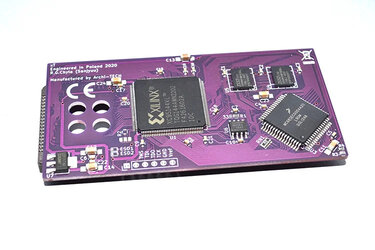The A600 was pretty much the most pointless Amiga made and was an amazing example of Commodore's mismanagement for the time but with modern needs and sensibilities, it's an alright machine. ECS chipset, easily expandable to 2 MB of chipram, tiny, IDE, PCMCIA slot. The latter is a lot more useful now than it was back then, You can stick a CF card (Or SD card, with adapter) into it and basically use it like a card reader/external drive which of course is super convenient. I was also considering going with an A1200, as AGA is an improvement (18-24 bit color palette, max. 256 colors vs, 32 out of 4096, 14 Mhz chipset, partitally 32 bit) and I have accelerators for my A1200s but that's somehow not what the Amiga was at for me. Also it'll take a while before something like the RGB2HDMI will exist for those color depths.
I ended up getting an accelerator for mine, since 3.1 Workbench usage on the original CPU can be sluggish sometimes, especially with no FastRAM. There is a lot of fancy and very fast accelerators you can buy nowadays for the A600, but for an OCS/ECS system IMO they are kind of pointless. You'll always be weighted down by the slow chipset. The few number crunchy operations (3D rendering, compiling of big programs, internet browsing, playing mp3s, large file I/O) which aren't too chipset dependant will also be slow and a poor experience on everything besides the PiStorm and do you really want to do this stuff on a real Amiga? I don't.

(picture not mine)
There is zero documentation on it besides a short wiki page in polish and an equally polish youtube video. Considering the communities hunt for the longer benchmark bar I doubt it's very popular and indeed, there is very little talk about it. It's a nice and simple design though, the CPU is clocked at 28 Mhz and it has about 12 MB of usable RAM. (which is a lot for an Amiga, I would've been happy with 4. Interestingly, it can add an additional 1,5 MB "SlowRAM/Trapdoor RAM" at the appropiate address. This won't be "true" SlowRAM at all though and indeed be just as fast as the FastRAM) There is a CLPD, some RAM, 3.3V regulation, and a 68SEC000, which is the 68k for embedded applications, but for all intents the same CPU as the original 68k in how the Amiga uses it. At 28 Mhz, it's about double as fast as the 14 Mhz EC020 CPU in the A1200, since that CPU has no FastRAM. U6 (the small chip next to the CPU in the corner) is the
ICS501M, which is a clock multiplier. What this expansion does is take the 7 Mhz that the socketed 68k gets from the system, and then multiply it up to approx. 28 MHz. That way we stay synchronous to the chipset. If you turn the turbo off, all it does is run the SEC from the 7 Mhz. (this was probably designed this way to make the RAM still usable, it would have been more complex to make it available to the original CPU and they're functionally the same anyways at the same speed)
The SEC was used in the Minimig, which was an Amiga reproduction from the 00s that had the entire OCS chipset realized in a single FPGA but used this processor as CPU. In these days people found out that you can clock the SEC quite agressively, and in some minimig revisions it runs at 50 Mhz, which is a lot considering the part is rated at 20 Mhz. This puts it about at the speed of a slower 030, with none of the extra instructions and 32 bit bus goodness though. Since a static design of the 68k was kinda trivial in the late 90s, and this was intended to be for embedded applications in a wide variety of situations, it makes sense that the chip is quite robust in it's margins. Motorola's max. ratings were always quite conservative. Although this chip is already overclocked here, it stays at room temperature. That said, for an Amiga part it is in a nice sweet spot of speed. My installation with patches, commodities and all boots in about 4 seconds from IDE, progams load almost instantly and the "killer apps" of the day like Brilliance, Deluxe Paint, FinalCalc, TurboText etc. work nicely and you can easily multitask with all of that RAM. It exactly where it helps some of these applications and games to get over that lag some of them had without running everything too fast or feeling "ridiculous"(for the lack of a better word) and since it has no cache, when all happens from chipram the speed gain is very minimal. You rarely have to disable the turbo, even when playing old games directly from floppy.
I then got curious and measured out what the two clock multiplicator settings pins are connected to, and sure enough - they are not directly connected to GND which is all they would need to run at 28 Mhz (4x setting) but to two distinct pins of the CLPD, which might either mean the designer intended to leave the speed the CPU can be set at open not to pcb manufaturing time but to CLPD programming time or made them software controllable in a hidden way. Time to poke around a bit.
(There's something I dub 'the Amiga effect' where the entire OS is just super inviting to tinker around with. Since I set the machine up on my workbench I drew a new mouse cursor, made parts of an old timey font and doodled around in Brilliance. It's just engaging and inviting that way. I plan to do a few things with it when I have my faux modem built.)
